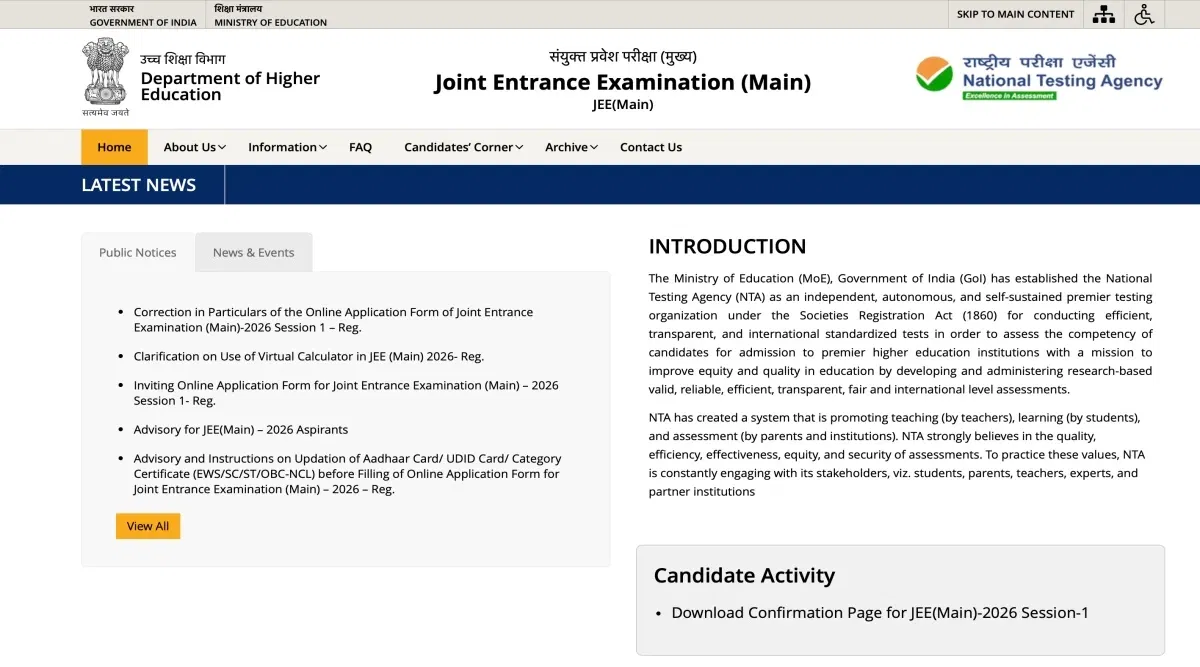JEE Main Vector questions are framed around the core concepts of Coplanar Vectors, Projection Of Vectors, Vector Product, Orthogonal Vector, Triple Vector Product, Parallelogram Laws Of Vector. Candidates must be thorough with the concepts to score good marks in this national-level entrance exam.
Table of Contents
The top 10 JEE Main Vector questions that are highly expected in JEE Mains 2026 cover Vector Algebra, Vector Components, Cross Product, Position Vectors, Scalar Vectors, Multiplication Of Vectors, Vector Triple Product, Subtraction Of Vector, Direction Cosines And Magnitude, Orthogonal Vector.
JEE Main 2026 Session 2 will be conducted in Apr 2026. The JEE Main 2026 admit cards for the exams in Apr 2026 will be released by the National Testing Agency in Mar 2026. The admit cards for the other exams shall be released shortly.
Topic of Contents:
Top 10 JEE Main Vector Questions with Solutions
The top 10 JEE Main Vector questions with answers are listed below for students to practise to prepare the Vector topics.
Question 1: If a, b and c are unit vectors, then |a − b|2 + |b − c|2 + |c − a|2 does not exceed
A) 4
B) 9
C) 8
D) 6
Answer: |a − b|2 + |b − c|2 + |c − a|2 = 2 (a2 + b2 + c2) − 2 (a * b + b * c + c * a)
= 2 * 3 − 2 (a * b + b * c + c * a)
= 6 − {(a + b + c)2 − a2− b2 − c2}
= 9 − |a + b + c| 2 ≤ 9
Relevant articles related to JEE Main
Question 2: If three non-zero vectors are a = a1 i + a2 j + a3 k, b = b1 i + b2 j + b3 k and c = c1 i + c2 j + c3 k. If c is the unit vector perpendicular to the vectors a and b and the angle between a and b is π / 6, then it is equal to ________.
Answer: |c| = 1, we have |c|2 = 1 or c21 + c22 + c23 = 1 …..(i)
Again, since c ⊥ a and c ⊥ b, we have c * a = 0
= a1c1 + a2c2 + a3c3 = 0 …..(ii) and
c * b = 0 = b1c1 + b2c2 + b3c3 = 0 ..…(iii)
Also, since the angle between a and b is π / 6, we have a * b = a1b1 + a2b2 + a3b3
|a| * |b| * cos [π / 6] = a1b1 + a2b2 + a3b3
[3 / 4] (a21 + a22 + a23) (b21 + b22 + b23) = (a1c1 + a2c2 + a3c3)2 …..(iv)
= [1 / 4] (a21 + a22 + a23) (b21 + b22 + b23), {Using (iv)}
= [(Σa21) * (Σb21)] / [4],
where Σa21 = a21 + a22 + a23 and Σb21 = b21 + b22 + b23.
Question 3: Let b = 4i + 3j and c be two vectors perpendicular to each other in the xy-plane. All vectors in the same plane having projections 1 and 2 along b and c, respectively, are given by __?
Answer: Let r = λb + μc and c = ± (xi + yj).
Since c and b are perpendicular, we have 4x + 3y = 0
= c = ±x (i − 43j), {Because, y = [−4 / 3]x}
Now, the projection of r on b = [r. b] / [|b|] = 1
= [(λb + μc) . b] / [|b|]
= [λb. B] / [|b|] = 1
= λ = 1 / 5
Again, projection of r on c = [r. c] / [|c|] = 2
This gives μx = [6 / 5]
= r = [1 / 5] (4i + 3j) + [6 / 5] (i − [4 / 3]j)
= 2i−j or
r = [1 / 5] (4i + 3j) − [6 / 5] (i − [4 / 3]j)
= [−2 / 5] i + [11 / 5] j
Question 4: A vector has components 2p and 1 with respect to a rectangular cartesian system. The system is rotated through a certain angle about the origin in the anti-clockwise sense. If a has components p + 1 and 1 with respect to the new system, then find p.
Answer: If x, y are the original components, X, Y the new components, and α is the angle of rotation, then x = X cosα − Y sinα and y = X sinα + Y cosα
Therefore, 2p = (p + 1) cosα − sinα and 1 = (p + 1) sinα + cosα
Squaring and adding, we get 4p2 + 1 = (p + 1)2 + 1
= p + 1 = ± 2p
= p = 1 or −1 / 3
Question 5: If b and c are any two non-collinear unit vectors and a is any vector, then (a . b) b + (a . c) c + [a. (b × c) / |b × c|] (b × c) = ____?
Answer: Let i be a unit vector in the direction of b j in the direction of c.
Note that b = i and c = j
We have b × c = |b| |c| sinαk = sinαk, where k is a unit vector perpendicular to b and c. = |b × c| = sinα
= k = [b × c] / [|b × c|]
Any vector a can be written as a linear combination of i, j and k.
Let a =a1i + a2j + a3k
Now a . b = a . i = a1, a . c = a . j = a2 and {[a] . [b × c] / [|b × c|]} = a . k = a3
Thus, (a . b) b + (a . c) c + {[a] . [(b × c) / |b × c|] * [(b × c)|]}
= a1b + a2c + a3 [b × c] / [|b × c|]
= a1i + a2j + a3k
= a
Question 6: Let p, q, r be three mutually perpendicular vectors of the same magnitude. If a vector x satisfies equation p × {(x − q) × p} + q × {(x − r) × q} + r × {(x − p) × r} = 0, then x is given by ___?
Answer: |p| = |q| = |r| = c, (say) and
p . q = 0 = p . r = q . r
p × |( x − q) × p |+ q × |(x − r) × q| + r × |( x − p) × r| = 0
= (p . p) (x − q) − {p . (x − q)} p + . . . . . . . . . = 0
= c2 (x − q + x − r + x − p) − (p . x) p − (q . x) q − (r . x) r = 0
= c2 {3x − (p + q + r)} − [(p . x) p + (q . x) q + (r . x) r] = 0
which is satisfied by x = [1 / 2] (p + q+ r).
Question 7: a. [(b + c) × (a + b + c)] is equal to ___?
Answer: a. [(b + c) × (a + b + c)]
= a . (b × a + b × b + b × c) + a . (c × a + c × b + c × c)
= [aba] + [abb] + [a b c] + [aca] + [a c b] + [a c c]
= 0 + 0 + [abc] + 0 − [abc] + 0
= 0
Question 8: The horizontal force and the force inclined at an angle 60o with the vertical, whose resultant is in the vertical direction of ‘P’ kg, are ___?
Answer: Let F1 be the horizontal force, and P is the vertical force.
Let F2 be the force inclined at 600 with vertical.
The result is P.
So we can write F1 i + (-F2 cos 30 i + F2 cos 60 j) = Pj
Equating coefficients
F1 – (√3/2) F2 = 0
F2/2 = P
F2 = 2P
So F1 = √3 P
Question 9: Let a, b and c be vectors with magnitudes 3, 4 and 5, respectively and a + b + c = 0, then the values of a . b + b. c + c . a, is ____?
Answer: Since a + b + c = 0
On squaring both sides, we get
|a|2 + |b|2 + |c|2 + 2 (a . b + b . c + c . a) = 0
= 2 (a . b + b . c + c . a) = − (9 + 16 + 25)
= a . b + b . c + c . a = −25
Question 10: The magnitudes of mutually perpendicular forces a, b and c are 2, 10 and 11, respectively. Then, the magnitude of its resultant is ______.
Answer:R = √[22 + 102 + 112].
= √[4 + 100 + 121]
= 15







![Indian Institute of Technology, [IIT] Kanpur](https://media.getmyuni.com/azure/college-image/small/indian-institute-of-technology-iit-kanpur.jpg)
![Indian Institute of Technology, [IIT] Roorkee](https://media.getmyuni.com/azure/college-image/small/indian-institute-of-technology-iit-roorkee.jpg)
![Jawaharlal Nehru University, [JNU] New Delhi](https://media.getmyuni.com/azure/college-image/small/jawaharlal-nehru-university-jnu-new-delhi.jpg)
![University of Calcutta, [UC] Kolkata](https://media.getmyuni.com/azure/college-image/small/university-of-calcutta-uc-kolkata.jpg)





























POST YOUR COMMENT